Harpies
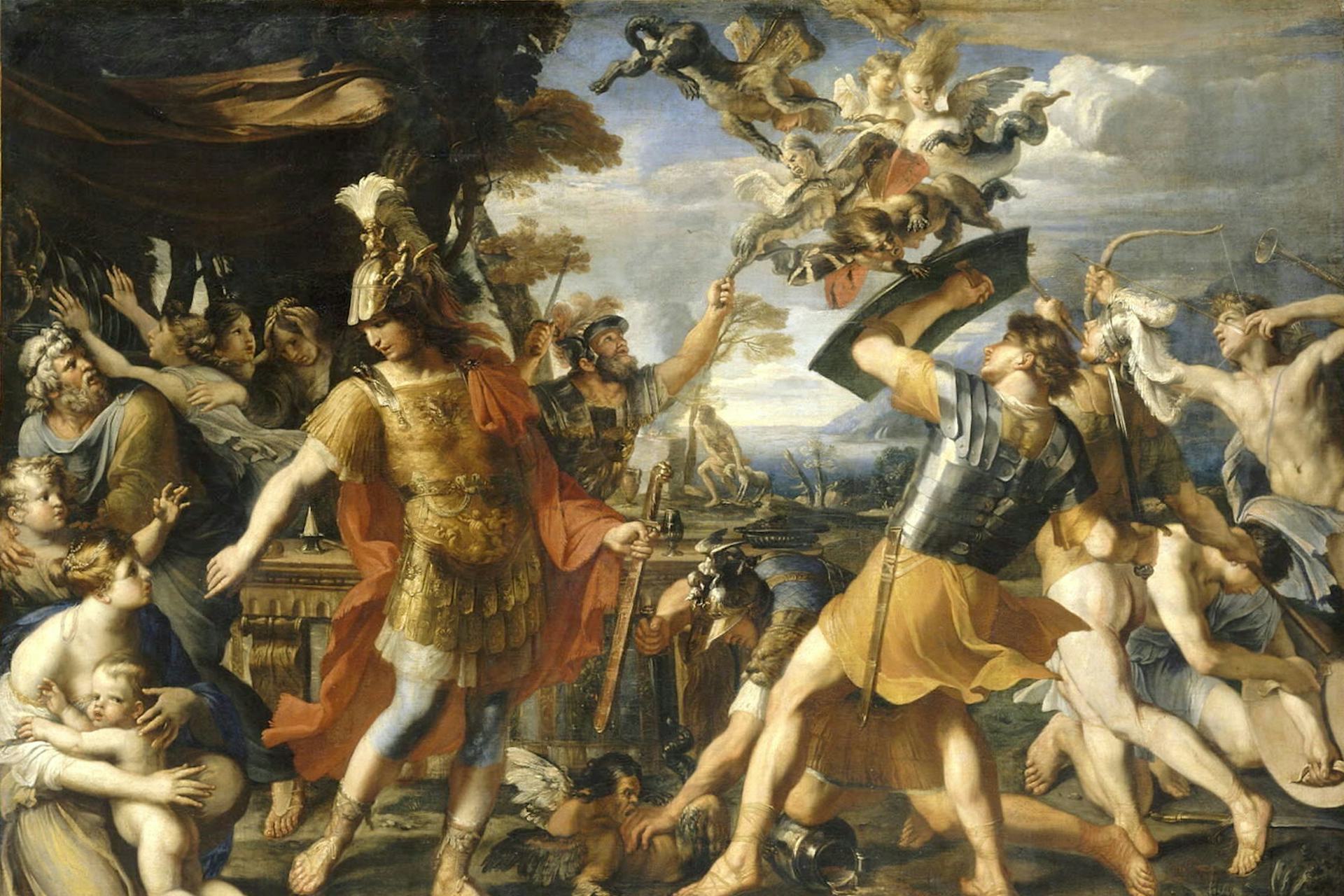
Aeneas and his companions fighting the Harpies by François Perrier (ca. 1645–46).
LouvrePublic DomainOverview
The Harpies were winged female monsters, said to be descended from the sea god Thaumas and the Oceanid Electra (though there were many alternative versions of their lineage). They represented storms and storm winds that were powerful enough to snatch people from the earth. Early sources spoke of two Harpies, while later texts often added a third.
The Harpies were best known for tormenting King Phineus of Thrace; they continuously stole or contaminated his food until they were finally chased away by the heroes Calais and Zetes (also known as the Boreads). In some traditions, Calais and Zetes slew the Harpies, while in others they merely pursued the monsters to a remote island west of Greece.
Etymology
In antiquity, the term “Harpy” (Greek ἅρπυια, translit. hárpyia; pl. “Harpies,” Greek ἅρπυιαι, translit. hárpyiai) was thought to come from the Greek word ἁρπάζω (harpázō)[1] or ἀνερείπομαι (anereípomai)[2], meaning “to snatch” or “to rob.” Their name could thus be translated as “the Snatchers.”
Scholars today, however, are less certain about the true origins of the term; they generally regard the ancient etymologies as artificial or “folk” etymologies.[3]
Some sources transmitted the names of individual Harpies, and the etymologies of these names tend to be more straightforward. These include Podarge (Greek Ποδάργη, translit. Podárgē), “Swift-Footed”;[4] Aello (Greek Ἀελλώ, translit. Aellṓ), “Storm Wind,”[5] sometimes called Aellopus (Greek Ἀελλόπους, translit. Aellópous), “Storm-Footed,”[6] or Nicothoe (Greek Νικοθόη, translit. Nikothóē), “Victory-Running”;[7] Ocypete (Greek Ὠκυπέτη, translit. Ōkypétē), “Swift-Winged,”[8] sometimes called Ocythoe (Greek Ὠκυθόη, translit. Ōkythóē), “Swift-Running,”[9] or Ocypode (Greek Ὠκυπόδη, translit. Ōkypódē), “Swift-Footed”;[10] and Celaeno (Greek Κελαινώ, translit. Kelainṓ), “Dark.”[11]
Pronunciation
English
Greek
Harpy, Harpies ἅρπυια, ἅρπυιαι (translit. hárpyia, hárpyiai) Phonetic
IPA
[HAHR-pee], [HAHR-peez] /ˈhɑr pi/, /ˈhɑr piz/
Titles and Epithets
Ancient authors would sometimes refer to the Harpies as the “dogs of Zeus.”[12]
Attributes
Catalog
According to most early sources (both literary and artistic), there were only two Harpies.[13] Later sources, however, often mentioned three Harpies,[14] while some did not specify a number at all.[15]
Ancient sources also disagreed on the names of the Harpies. Homer mentioned one Harpy named Podarge,[16] while Hesiod wrote of two Harpies, Aello and Ocypete.[17] According to Apollodorus, some sources used the names Nicothoe or Aellopus instead of Aello and Ocythoe, or Ocypode instead of Ocypete.[18] Virgil added another Harpy, Celaeno, though he did not specify the total number of Harpies.[19]
Later authorities who claimed there were three Harpies reported their names as either Celaeno, Ocypete, and Podarge;[20] Celaeno, Ocypete, and Aellopus;[21] or Celaeno, Ocypete, and Aello.[22]
Locales
The Harpies were best known for their mythical role as the tormentors of Phineus, the blind king of Thrace.[23] As a result, some ancient authorities claimed that the Harpies also lived in Thrace. In another important tradition, they lived in a cave or den somewhere in Crete.[24]
But the Harpies were most often associated with the Strophades (modern-day Strofades), a group of small Ionian islands off the western coast of Greece. It was said that the Boreads chased the Harpies to these islands before turning back, thus giving the islands their name (Strophades comes from the ancient Greek word meaning “to turn”).[25] The Harpies then either made their home on the Strophades, returned to Crete, or perished, depending on the version.[26]
In another tradition, the Harpies were also connected with the River Harpys (formerly the Tigres) in the Peloponnese, said to have been named for a Harpy who fell into it while escaping the Boreads. In another, the Harpies were numbered among the terrifying creatures who guarded the Underworld.[27]
Finally, one minor alternative tradition seems to have equated the Harpies with the Hesperides, making them the guardians of the famous Garden of the Hesperides, where the goddess Hera kept her golden apples.[28]
Appearance and Abilities
The Harpies, though not generally described in detail by ancient sources, were always represented as winged women. In their earliest representations, they had the faces of beautiful maidens.[29] But many sources, especially later ones, tended to stress their ugly or fearsome appearance.[30] A chilling description of the creatures is given in Book 3 of Virgil’s Aeneid:
Monsters more fierce offended Heav'n ne'er sent
From hell's abyss, for human punishment:
With virgin faces, but with wombs obscene,
Foul paunches, and with ordure still unclean;
With claws for hands, and looks for ever lean.[31]
Another source, the mythographer Hyginus, gives a more sober description of the creatures: “They are said to have been feathered, with cocks’ heads, wings, and human arms, with great claws; breasts, bellies, and female parts human.”[32]
The Harpies were known above all for their speed (a quality reflected in their individual names; see above). They were thought to snatch things away without a trace and thus represented or personified storm winds, which were powerful enough to lift a person from the earth.
Iconography
In ancient art, the Harpies were almost always shown as beautiful young women, winged but otherwise ordinary in appearance. Very rarely, they were depicted with further bird features, such as talons or claws. They would usually wear a short chiton, a kind of sleeveless tunic common in ancient Greece.
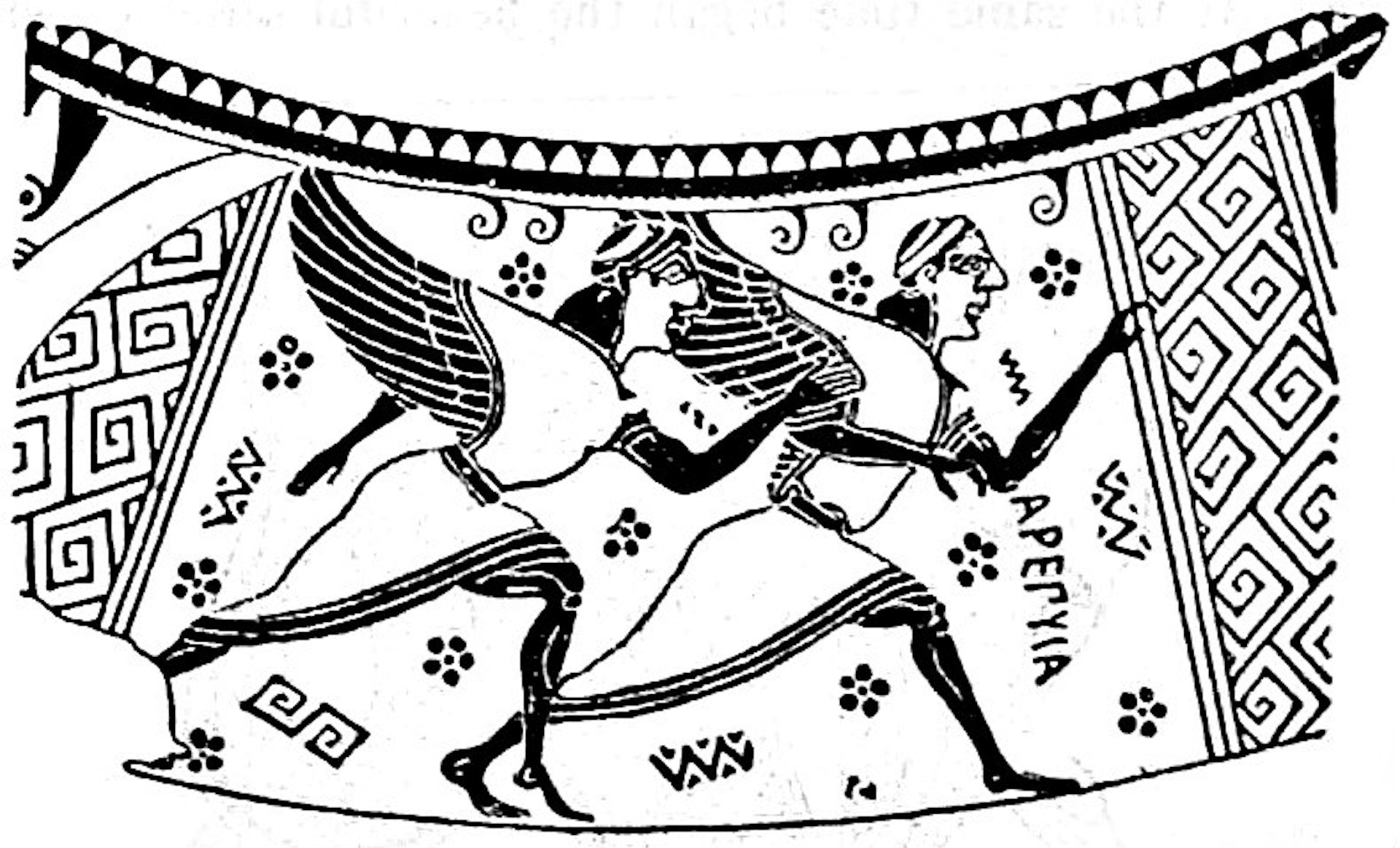
Drawing of winged Harpies, after lost black-figure louteion (ritual basin) of ca. 620 BCE.
Encyclopedia BrittanicaPublic DomainThe most popular scenes among ancient artists were the Harpies’ torment of Phineus and their pursuit by the Boreads. Certain depictions of these scenes, including on the Chest of Cypselus[33] and the Amyclae Throne,[34] were widely celebrated in antiquity. Harpies were especially popular in vase painting, but they also appeared in sculpture, painting, and mosaic.[35]
Family
Family Tree
Parents
Father
Mother
- Thaumas
- Electra (Oceanid)
Siblings
Sister
Mythology
Origins
The Harpies appear to have been conceived as personifications of storms and storm winds.[48] They were also associated with death. In one myth, for instance, they carried off the daughters of Pandareus to be the servants of the Erinyes, the Underworld goddesses of fate.[49]
The Harpies were very similar to the Sirens, another fantastic creature of Greek lore, and their historical origins may be similar. It is possible that both creatures were derived, at least in part, from the Egyptian Ba, the personification of the human soul leaving the body after death. Like the Harpies, the Ba was depicted as a human-headed bird.[50] The Harpies may have also been inspired by ornamental figures found on cauldrons from the civilization of Urartu, which flourished between the ninth and sixth centuries BCE.[51]
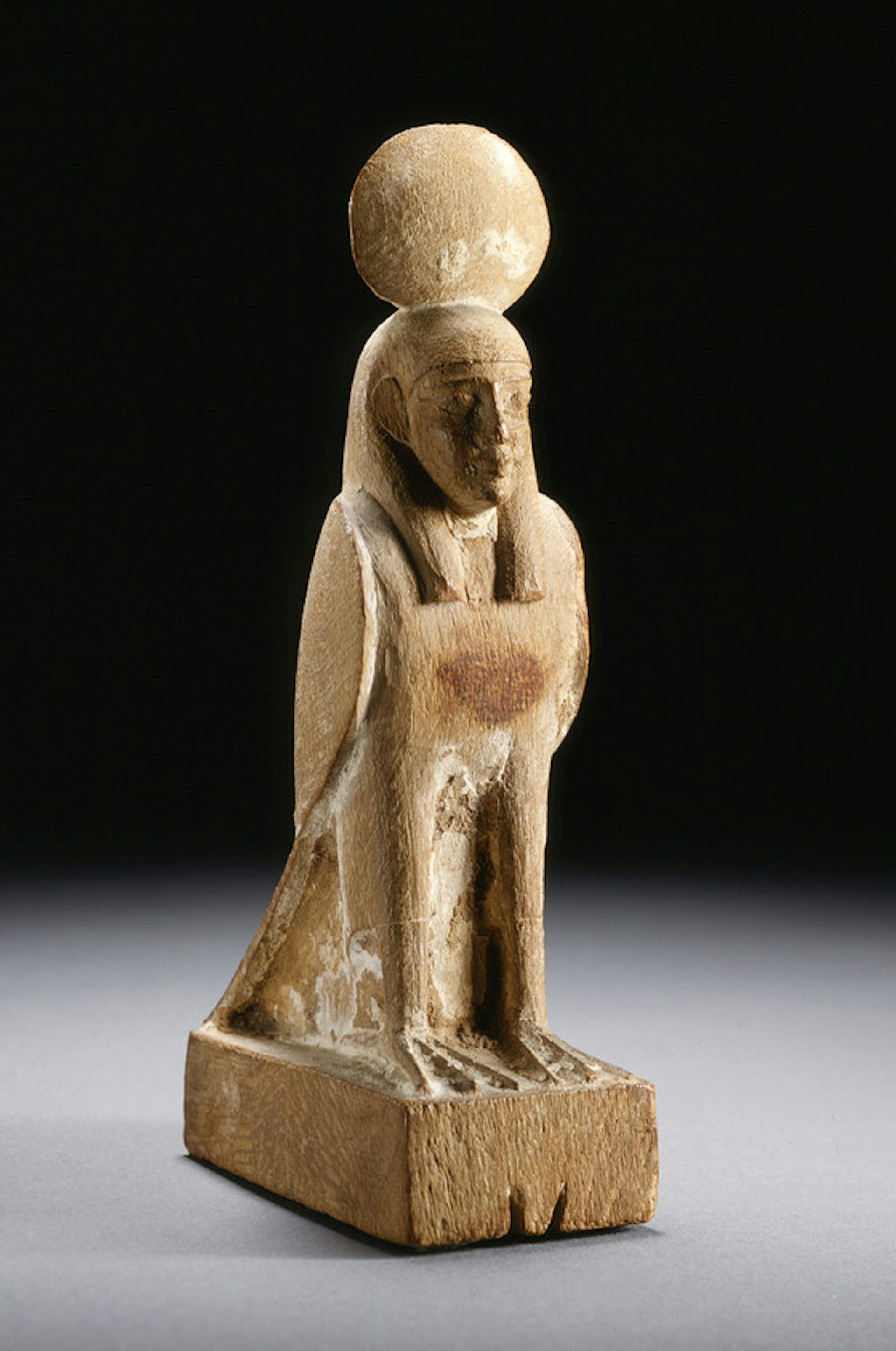
Wooden sculpture of the Ba, probably from the Egyptian New Kingdom (ca. 1550–1070 BCE).
Los Angeles County Museum of ArtPublic DomainThe Greeks themselves sometimes sought creative ways to explain the Harpies “rationally.” In one account, the Harpies were actually the human daughters of Phineus, the king of Thrace. These daughters, named Erasea and Harpyrea, led very wasteful lives—so wasteful, in fact, that they would have caused their father to starve had they not been chased away from his kingdom by the heroes Calais and Zetes.[52]
Phineus, the Argonauts, and the Boreads
The Harpies are mostly remembered for their role in the myth of the Argonauts. On their journey to Colchis to steal the Golden Fleece, the Argonauts stopped at Thrace. There, they met the blind Thracian king Phineus, who had angered the gods somehow and been inflicted with a terrible punishment: whenever he sat down to eat, the Harpies would swoop down upon him.[53] The vicious creatures would either snatch away his meal or make it inedible with their foul droppings.
Phineus knew that he was destined to be saved by the Argonauts Calais and Zetes, who were the winged sons of Boreas, god of the north wind (hence their alternate name, the Boreads). In return for their help, Phineus promised to foretell the dangers the Argonauts would face on their journey. Calais and Zetes agreed. They prepared a meal to lure the Harpies to Phineus and then waited nearby:
Scarcely had the aged man touched the food when they forthwith, like bitter blasts or flashes of lightning, suddenly darted from the clouds, and swooped down with a yell, fiercely craving for food; and the heroes beheld them and shouted in the midst of their onrush; but they at the cry devoured everything and sped away over the sea afar; and an intolerable stench remained.[54]
The Harpies fled through the air, the Boreads in hot pursuit. In one version, the Boreads chased the Harpies as far as the coast of western Greece. But when they reached the islands known as the Plotae or Echinades, one of the gods ordered the Boreads to let the Harpies go, promising that the creatures would never again torment Phineus.[55] The islands to which the Boreads had pursued the Harpies were henceforth called the Strophades, the islands of “turning,” to commemorate the occasion.[56]
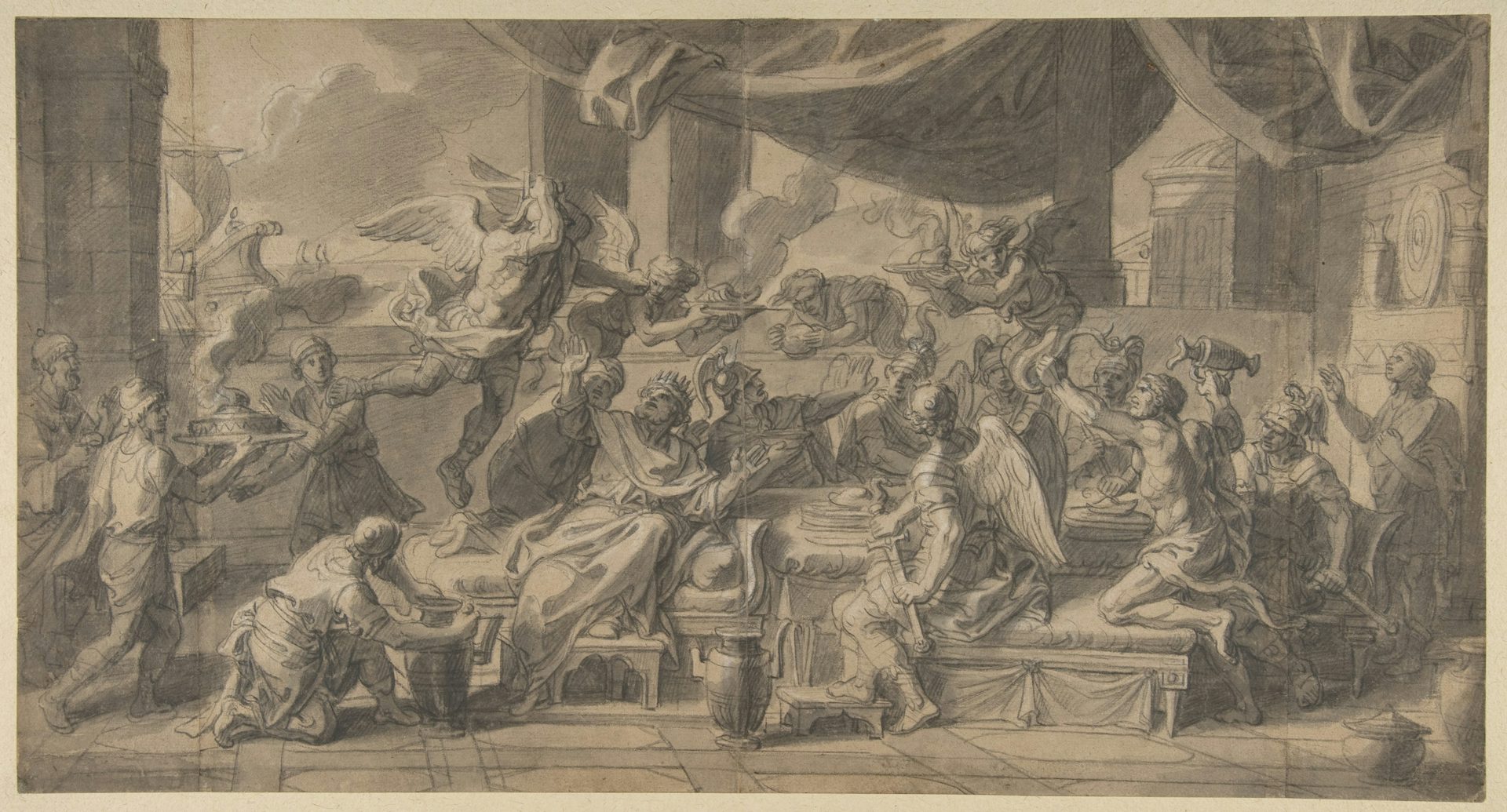
The Harpies Driven from the Table of King Phineus by Zetes and Calais by François Verdier (seventeenth or eighteenth century).
Metropolitan Museum of ArtPublic DomainIn another version, which did not end happily for either party, the Harpies were destined to be killed by the Boreads, while the Boreads were destined to die if they ever failed to catch what they were pursuing. Sure enough, both Harpies died as they tried to escape the Boreads: one of them fell into the River Tigres (which from then on was called the “Harpys”), while the other died of exhaustion as soon as she reached the Strophades. Since the Harpies had died before the Boreads could catch them, the Boreads also fell dead (or perhaps were killed soon afterwards).[57]
There seems to have been another version of the myth, too, in which the Boreads did catch and kill the Harpies (perhaps near Rhegium in southern Italy). Unfortunately, this tradition survives only in fragments.[58]
Celaeno’s Prophecy
The Harpies also made an appearance in Virgil’s account of the wanderings of Aeneas in Book 3 of the Aeneid. According to this tale, Aeneas and his men stopped at the Strophades on their way to Italy, which was destined to be their new home. But they were plagued by the Harpies, who snatched away their meals.
Aeneas and his men promptly retaliated, arming themselves and fighting the hideous creatures. Though the Harpies were immune to their weapons, Aeneas and his men did manage to drive them away. But one of the Harpies, Celaeno, lingered long enough to declare that Aeneas had sinned in trying to harm the Harpies and that he and his followers would suffer a punishment that fit their crime:
You seek th’ Italian shores, foredoom’d by fate:
Th’ Italian shores are granted you to find,
And a safe passage to the port assign’d.
But know, that ere your promis’d walls you build,
My curses shall severely be fulfill’d.
Fierce famine is your lot for this misdeed,
Reduc’d to grind the plates on which you feed.[59]
Much later, when Aeneas and his followers did finally reach Italy, they prepared a meal of vegetables, which they piled on top of flatbread “plates.” After finishing their meal, they were still so hungry that they ate these makeshift plates. Thus, while Celaeno’s frightening prophecy turned out to be true, it was also relatively harmless.[60]
Pop Culture
The Harpies have remained prominent in Western culture. Today they are familiar not only from ancient Greek and Roman literature but also from the works of authors such as Dante and Shakespeare and artists such as William Blake. Harpies still feature in some modern adaptations of Greek mythology (for instance, the 1990s TV series Xena: Warrior Princess), where they are typically represented as fearsome, grotesque creatures.
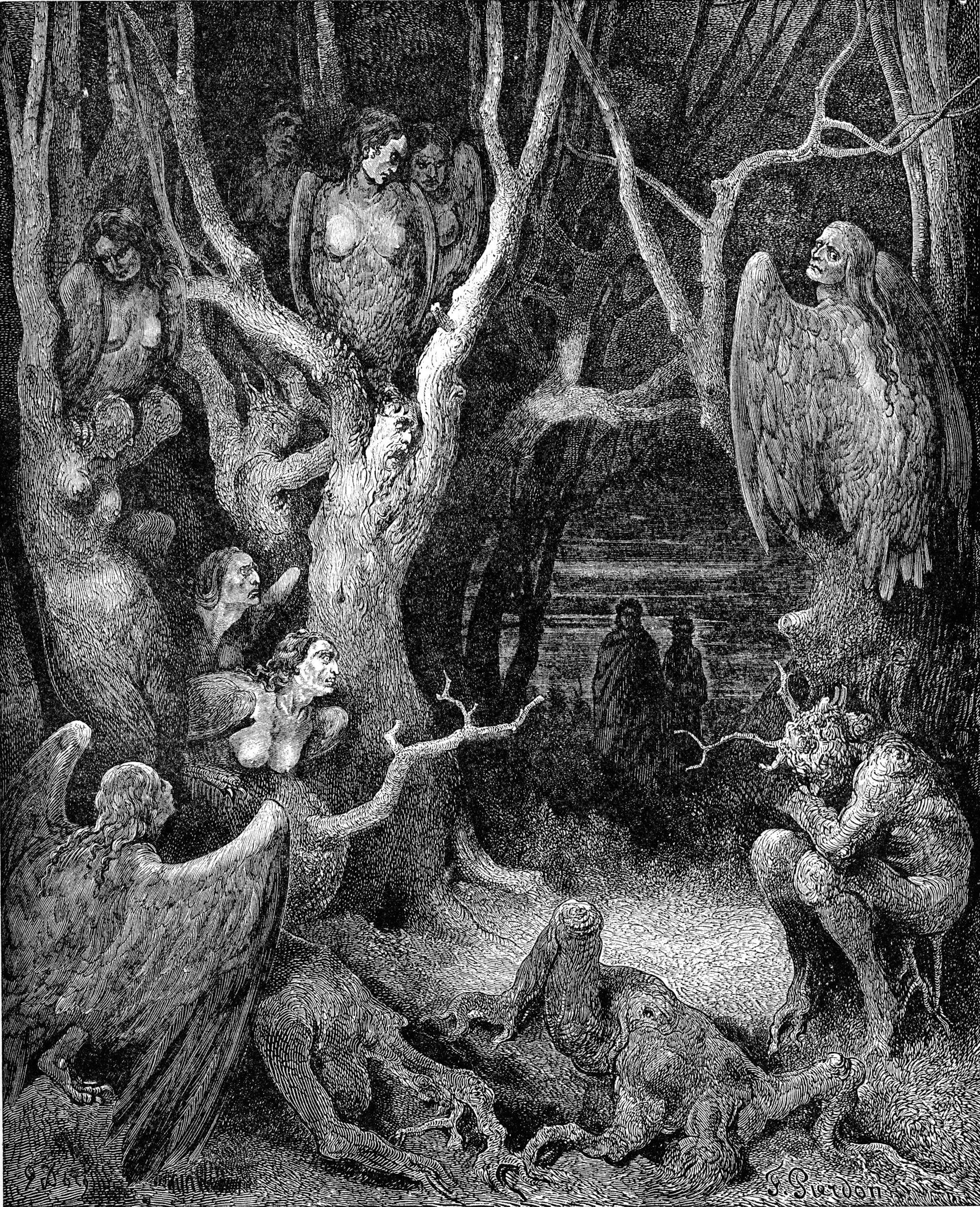
Illustration of the Harpies in the forest of the suicides from Canto XIII of Dante’s Inferno. Gustave Dore, 19th Century.
Wikimedia CommonsPublic Domain